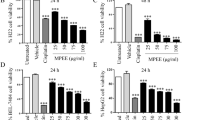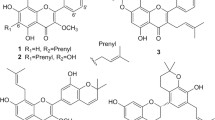Abstract
Natural flavonoids from plants have been demonstrated to possess promising chemopreventive activities against various diseases. 7-{4-[Bis-(2-hydroxy-ethyl)-amino]-butoxy}-5-hydroxy-8-methoxy-2-phenyl-chromen-4-one (V8), a newly synthesized derivative of wogonin may have antioxidant, antiviral, anti-inflammatory and anti-tumor potentials as wogonin. Based on the recent findings of V8, the anti-tumor activities and fundamental mechanisms by which V8 inhibits growth of hepatocellular carcinoma were further investigated in this study. After the treatment of V8, a significant inhibition of HepG2 cell proliferation was observed in a dose-dependent manner with the IC50 value of 23 μM using MTT assay. The exposure to V8 also resulted in apoptosis induction and an accumulation of ROS and Ca2+. Meanwhile, a release of cytochrome c (Cyt-c), activation of BH-3 only proteins and Bax, decrease in mitochondrial membrane potential ΔΨ, as well as a suppression of Bcl-2, pro-caspase9 and pro-caspase3 expression were shown. Moreover, knocking down CHOP partly decreased the effect of V8-mediated apoptosis and activation of GRP78, p-PERK, p-eIF2α, ATF4 and CHOP modulated ER stress triggered by V8. In vivo, V8 inhibited the transplanted mice H22 liver carcinomas in a dose-dependent manner. Compared with wogonin, V8 exhibited stronger anti-proliferative effects both in vitro and in vivo. The underlying mechanism of activating PERK-eIF2α-ATF4 pathway by which V8 induces apoptosis was verified once again in vivo. The apoptosis induction via the mitochondrial pathway by modulating the ROS-mediated ER signaling pathway might serve to provide support for further studies of V8 as a possible anticancer drug in the clinical treatment of cancer.







Similar content being viewed by others
Abbreviations
- ROS:
-
Reactive oxygen species
- ER:
-
Endoplasmic reticulum
- HCC:
-
Hepatocellular carcinoma
- UPR:
-
Unfolded protein response
- ΔΨm:
-
Mitochondrial transmembrane potential
- CHOP:
-
CCAAT/enhancer-binding protein–homologous protein
- DMSO:
-
Dimethyl sulfoxide
- NAC:
-
N-acetyl cysteine
- carboxy-H2DCFDA:
-
Dichlorofluorescein diacetate
- ERAD:
-
ER-associated degradation
References
Anding AL, Chapman JS, Barnett DW, Curley RW Jr, Clagett-Dame M (2007) The unhydrolyzable fenretinide analogue 4-hydroxybenzylretinone induces the proapoptotic genes GADD153 (CHOP) and Bcl-2-binding component 3 (PUMA) and apoptosis that is caspase- dependent and independent of the retinoic acid receptor. Cancer Res 67(13):6270–6277. doi:10.1158/0008-5472.CAN-07-0727
Bruix J, Llovet JM (2009) Major achievements in hepatocellular carcinoma. Lancet 373(9664):614–616. doi:10.1016/S0140-6736(09)60381-0
El-Serag HB (2011) Hepatocellular carcinoma. N Engl J Med 365(12):1118–1127. doi:10.1056/NEJMra1001683
Friedman AD (1996) GADD153/CHOP, a DNA damage-inducible protein, reduced CAAT/enhancer binding protein activities and increased apoptosis in 32D c13 myeloid cells. Cancer Res 56(14):3250–3256
Gish RG, Baron A (2008) Hepatocellular carcinoma (HCC): current and evolving therapies. IDrugs 11(3):198–203
Hetz C, Bernasconi P, Fisher J et al (2006) Proapoptotic BAX and BAK modulate the unfolded protein response by a direct interaction with IRE1alpha. Science 312(5773):572–576. doi:10.1126/science.1123480
Hotokezaka Y, van Leyen K, Lo EH et al (2009) alphaNAC depletion as an initiator of ER stress-induced apoptosis in hypoxia. Cell Death Differ 16(11):1505–1514. doi:10.1038/cdd.2009.90
Jemal A, Bray F, Center MM, Ferlay J, Ward E, Forman D (2011) Global cancer statistics. CA Cancer J Clin 61(2):69–90. doi:10.3322/caac.20107
Kim I, Xu W, Reed JC (2008) Cell death and endoplasmic reticulum stress: disease relevance and therapeutic opportunities. Nat Rev Drug Discov 7(12):1013–1030. doi:10.1038/nrd2755
King A, Gottlieb E, Brooks DG, Murphy MP, Dunaief JL (2004) Mitochondria-derived reactive oxygen species mediate blue light-induced death of retinal pigment epithelial cells. Photochem Photobiol 79(5):470–475
Kruidering M, Evan GI (2000) Caspase-8 in apoptosis: the beginning of “the end”? IUBMB Life 50(2):85–90. doi:10.1080/713803693
Li J, Lee B, Lee AS (2006) Endoplasmic reticulum stress-induced apoptosis: multiple pathways and activation of p53-up-regulated modulator of apoptosis (PUMA) and NOXA by p53. J Biol Chem 281(11):7260–7270. doi:10.1074/jbc.M509868200
Lin JH, Li H, Yasumura D et al (2007) IRE1 signaling affects cell fate during the unfolded protein response. Science 318(5852):944–949. doi:10.1126/science.1146361
Lin CC, Kuo CL, Lee MH et al (2011) Wogonin triggers apoptosis in human osteosarcoma U-2 OS cells through the endoplasmic reticulum stress, mitochondrial dysfunction and caspase-3-dependent signaling pathways. Int J Oncol 39(1):217–224. doi:10.3892/ijo.2011.1027
Li-Weber M (2009) New therapeutic aspects of flavones: the anticancer properties of scutellaria and its main active constituents wogonin baicalein and baicalin. Cancer Treat Rev 35(1):57–68. doi:10.1016/j.ctrv.2008.09.005
Llovet JM, Ricci S, Mazzaferro V et al (2008) Sorafenib in advanced hepatocellular carcinoma. N Engl J Med 359(4):378–390. doi:10.1056/NEJMoa0708857
Lluis JM, Buricchi F, Chiarugi P, Morales A, Fernandez-Checa JC (2007) Dual role of mitochondrial reactive oxygen species in hypoxia signaling: activation of nuclear factor-{kappa}B via c-SRC and oxidant-dependent cell death. Cancer Res 67(15):7368–7377. doi:10.1158/0008-5472.CAN-07-0515
McCullough KD, Martindale JL, Klotz LO, Aw TY, Holbrook NJ (2001) Gadd153 sensitizes cells to endoplasmic reticulum stress by down-regulating Bcl2 and perturbing the cellular redox state. Mol Cell Biol 21(4):1249–1259. doi:10.1128/MCB.21.4.1249-1259.2001
Moenner M, Pluquet O, Bouchecareilh M, Chevet E (2007) Integrated endoplasmic reticulum stress responses in cancer. Cancer Res 67(22):10631–10634. doi:10.1158/0008-5472.CAN-07-1705
Motola-Kuba D, Zamora-Valdes D, Uribe M, Mendez-Sanchez N (2006) Hepatocellular carcinoma. An overview. Ann Hepatol 5(1):16–24
Noori S, Hassan ZM (2012) Tehranolide inhibits proliferation of MCF-7 human breast cancer cells by inducing G0/G1 arrest and apoptosis. Free Radic Biol Med 52(9):1987–1999. doi:10.1016/j.freeradbiomed.2012.01.026
Ola MS, Nawaz M, Ahsan H (2011) Role of Bcl-2 family proteins and caspases in the regulation of apoptosis. Mol Cell Biochem 351(1–2):41–58. doi:10.1007/s11010-010-0709-x
Oyadomari S, Mori M (2004) Roles of CHOP/GADD153 in endoplasmic reticulum stress. Cell Death Differ 11(4):381–389. doi:10.1038/sj.cdd.4401373
Rao RV, Ellerby HM, Bredesen DE (2004) Coupling endoplasmic reticulum stress to the cell death program. Cell Death Differ 11(4):372–380. doi:10.1038/sj.cdd.4401378
Ron D, Walter P (2007) Signal integration in the endoplasmic reticulum unfolded protein response. Nat Rev Mol Cell Biol 8(7):519–529. doi:10.1038/nrm2199
Sanges D, Marigo V (2006) Cross-talk between two apoptotic pathways activated by endoplasmic reticulum stress: differential contribution of caspase-12 and AIF. Apoptosis 11(9):1629–1641. doi:10.1007/s10495-006-9006-2
Sugiyama T, Shimizu S, Matsuoka Y, Yoneda Y, Tsujimoto Y (2002) Activation of mitochondrial voltage-dependent anion channel by apro-apoptotic BH3-only protein Bim. Oncogene 21(32):4944–4956. doi:10.1038/sj.onc.1205621
Surh YJ (2003) Cancer chemoprevention with dietary phytochemicals. Nat Rev Cancer 3(10):768–780. doi:10.1038/nrc1189
Szegezdi E, Logue SE, Gorman AM, Samali A (2006) Mediators of endoplasmic reticulum stress-induced apoptosis. EMBO Rep 7(9):880–885. doi:10.1038/sj.embor.7400779
Tabas I, Ron D (2011) Integrating the mechanisms of apoptosis induced by endoplasmic reticulum stress. Nat Cell Biol 13(3):184–190. doi:10.1038/ncb0311-184
Takemoto K, Miyata S, Takamura H, Katayama T, Tohyama M (2011) Mitochondrial TRAP1 regulates the unfolded protein response in the endoplasmic reticulum. Neurochem Int 58(8):880–887. doi:10.1016/j.neuint.2011.02.015
Ureshino N, Aragane N, Nakamura T et al (2011) A fully integrated and automated detection system for single nucleotide polymorphisms of UGT1A1 and CYP2C19. Oncol Res 19(3–4):111–114
Verfaillie T, Garg AD, Agostinis P (2010) Targeting ER stress induced apoptosis and inflammation in cancer. Cancer Lett. doi:10.1016/j.canlet.2010.07.016
Wang X, Wang B, Fan Z, Shi X, Ke ZJ, Luo J (2007) Thiamine deficiency induces endoplasmic reticulum stress in neurons. Neuroscience 144(3):1045–1056. doi:10.1016/j.neuroscience.2006.10.008
Whittaker S, Marais R, Zhu AX (2010) The role of signaling pathways in the development and treatment of hepatocellular carcinoma. Oncogene 29(36):4989–5005. doi:10.1038/onc.2010.236
Xu C, Bailly-Maitre B, Reed JC (2005) Endoplasmic reticulum stress: cell life and death decisions. J Clin Invest 115(10):2656–2664. doi:10.1172/JCI26373
Xu M, Lu N, Sun Z et al (2012) Activation of the unfolded protein response contributed to the selective cytotoxicity of oroxylin A in human hepatocellular carcinoma HepG2 cells. Toxicol Lett 212(2):113–125. doi:10.1016/j.toxlet.2012.05.008
Ye SL (2008) Current aspects on standard therapy for primary hepatocellular carcinoma. Zhonghua Gan Zang Bing Za Zhi 16(1):1–2
Yoshida H, Matsui T, Hosokawa N, Kaufman RJ, Nagata K, Mori K (2003) A time-dependent phase shift in the mammalian unfolded protein response. Dev Cell 4(2):265–271
Zinszner H, Kuroda M, Wang X et al (1998) CHOP is implicated in programmed cell death in response to impaired function of the endoplasmic reticulum. Genes Dev 12(7):982–995
Acknowledgments
This work was supported by Program for Changjiang Scholars and Innovative Research Team in University (IRT1193), the Project Program of State Key Laboratory of Natural Medicines, China Pharmaceutical University(No. JKGZ201101), the National Science & Technology Major Project (No.2012ZX09304-001) and Natural Science Foundation of Jiangsu province (No.BK2009297 and No.BK2010432).
Author information
Authors and Affiliations
Corresponding authors
Additional information
Yi Zhang and Li Zhao have contributed equally to this article.
Rights and permissions
About this article
Cite this article
Zhang, Y., Zhao, L., Li, X. et al. V8, a newly synthetic flavonoid, induces apoptosis through ROS-mediated ER stress pathway in hepatocellular carcinoma. Arch Toxicol 88, 97–107 (2014). https://doi.org/10.1007/s00204-013-1085-6
Received:
Accepted:
Published:
Issue Date:
DOI: https://doi.org/10.1007/s00204-013-1085-6




